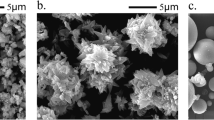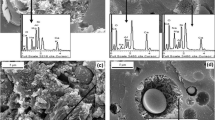Abstract
A microstructural study of mortars prepared with a low-alkali, low-C3A cement and a Class F fly ash, both of Swedish origin, was carried out using the scanning electron microscopy-energy-dispersive X-ray analytical technique. Supplementary phase analyses were made by X-ray diffraction and thermogravimetry-differential thermal analysis. Normally, CH crystals in the transition zone grow with their c axis parallel (or the (0 0 1) cleavage plane perpendicular) to the aggregate surface. The encapsulation of the fly ash particles by the growing CH reduces the amount of orientated CH at the aggregate-paste interface. The growth mechanism of these crystals is discussed. The reduction of CH, most significant after 28 days of hydration, is mainly due to the reaction of CH with the fly ash glass phase. Initially, the replacement of cement by fly ash weakens the paste-aggregate interfacial zone due to reduction of contact points, and increases the local water-to-cement ratio. This, however, improves significantly when the fly ash has reacted. In order to enhance the reaction of fly ash, extra gypsum was added. The results show that gypsum can accelerate the fly ash reaction, but the products formed, and the beneficial effects of gypsum, are mainly determined by the total amount of gypsum in the paste.
Resume
Une étude microstructurale de mortiers préparés à partir de ciment à faible teneur en alcali et en C3A ainsi que de cendres volantes de classe F (tous deux d’origine suédoise) a été menée en se servant du microscope électronique à balayage et de la technique d’analyse de rayons X à dispersion d’énergie. Les phases supplémentaires étaient étudiées par thermogravimétrie et analyse thermique différentielle.
Normalement, les critaux de CH croissent dans la zone de transition en sorte que leur axe est parallèle à la surface du granulat (ou le plan de clivage (0 0 1) perpendiculaire à la surface). En croissant le CH recouvre les cendres volantes, ce qui réduit la quantité de CH orienté à l’interface pâte-granulat. La diminution de CH, très importante après 28 jours, semble dépendre surtout de la réaction entre les cristaux de CH et la phase vitreuse des cendres volantes.
Au début de l’hydratation, l’addition de cendres volantes affaiblit la zone d’interface entre la pâte et le granulat en réduisant les points de contact. Le rapport eau-ciment local est aussi augmenté. Une fois que la réaction des cendres volantes commence, la situation s’améliore de façon significative. Afin d’augmenter la réactivité des cendres volantes, on a ajouté du gypse. Les résultats démontrent que, bien que le gypse puisse accélérer la réaction des cendres volantes, la formation de produits de réaction, ainsi que les avantages, dépendent de la quantité totale de gypse dans la pâte.
Similar content being viewed by others
References
Berry E. E. and Malhotra, V. M., ‘Fly Ash in Concrete’, CANMET, Ottawa; SP85-3 (1986).
Takemoto, K. and Uchikawa, H., ‘Hydration of pozzolanic cement’, in Proceedings of 7th International Congress on the Chemistry of Cement, Paris, 1980, Vol. I (Editions Septima, Paris) pp. IV-2–I-29.
Montgomery, D. G., Hughes, D. C. and Williams, R. I. T., y ‘Fly ash in concrete—a microstructure study’,Cem. Concr. Res. 11 (1981) 591–603.
Kokubu, M., ‘Fly ash and fly ash cement’, in Proceedings of 5th International Congress on Chemistry of Cement, Tokyo, 1968, Vol. IV (Cement Association of Japan, Tokyo) pp. 75–113.
Gutteridge, W. A. and Dalziel, J. A., ‘Filler cement: the effect of secondary component on the hydration of Portland cement, Part 2. Fine hydraulic binders’,Cem. Concr. Res. 20 (1990) 853–861.
Idem.,, ‘Filler cement: The effect of secondary component on the hydration of Portland cement, Part 1. A fine non-hydraulic filler’,ibid. 20 (1990) 778–782.
Diamond, S., ‘The characterization of fly ashes’, in ‘Effects of Fly Ash Incorporation in Cement and Concrete’, Materials Research Society Symposium N, Boston, 1981, pp. 12–23.
Cabrera, L. G. and Plowman, C., ‘The influence of pulverized fuel ash on the early and long term strength of concrete’, in Proceedings of 7th International Congress on the Chemistry of Cement, Paris, 1980, Vol. III (Editions Septima, Paris) pp. IV 84–92.
Huang, S., ‘Hydration of Fly Ash Cement and Microstructure of Fly Ash Cement Pastes’, CBI Research 2.81 (Swedish Cement and Concrete Research Institute, Stockholm, 1981).
Diamond, S., ‘Mimimal pozzolanic reaction in one year old fly ash pastes: an SEM evaluation’, in Proceedings of 11th International Conference on Cement Microscopy, New Orleans, 1989 (International Cement Microscopy Association, Duncanville, TX) pp. 263–274.
Xu, A. and Sarkar, S. L., ‘Gypsum activated fly ash hydration in cement pastes’,Cem. Concr. Res.,21 (1991) 1137–1147.
Wendlandt, W. W., ‘Thermal Analysis’, 3rd Edn (Wiley, London, 1986).
Pope, M. I. and Judd, M. D., ‘Differential Thermal Analysis’ (Heyden, London, 1977).
Ramachandran, V. S., ‘Estimation of Ca(OH)2 and Mg(OH)2—implications in cement chemistry’,Israel J. Chem. 22 (1982) 240–246.
Schwiete, H. E. and Ludwig, U., ‘Crystal structures and properties of cement hydration products (hydrated calcium aluminates and ferrites)’, in Proceedings of 5th International Symposium on the Chemistry of Cement, Tokyo, 1968, Vol. II (Cement Association of Japan, Tokyo) pp. 37–67.
Grandet, J. and Ollivier, J. P., ‘Nouvelle méthode d’étude des interfaces ciment-granulats’, Proceedings of 7th International Congress on the Chemistry of Cement, Paris, 1980, Vol. III (Editions Septima, Paris) pp. VII 85–89 (in French).
Larbi, J. A. and Bijen, J. M., ‘Evolution of lime and microstructural development in fly ash-Portland cement specimens’,Mater. Res. Soc. Symp. Proc. 178 (1990) 127–138.
Idem.,, ‘Orientation of calcium hydroxide at the Portland cement paste-aggregate interface in mortars in the presence of silica fume: a contribution’,Cem. Concr. Res. 20 (1990) 461–470.
Grandet, J. and Ollivier, J. P., ‘Orientation des hydrates au contact des granulats’, in Proceedings of 7th International Congress on the Chemistry of Cement, Paris, 1980, Vol. III (Editions Septima, Paris) pp. VII 63–68 (in French).
Barnes, B. D., Diamond, S. and Dolch, W. L., ‘The contact zone between Portland cement paste and glass “aggregate” surfaces’,Cem. Concr. Res. 8 (1978) 233–243.
Massazza, F. and Costa, U., ‘Bond: paste-aggregate, paste-reinforcement and paste-fibres’, in Proceedings of 8th international Congress on the Chemistry of Cement, Rio de Janeiro, 1986, Vol. I (Finep Publications, Rio de Janeiro) pp. 158–180.
Buckley, H. E., ‘Crystal Growth’ (Wiley, London, 1951).
Taylor, H. F. W., ‘Chemistry of cement hydration’, in Proceedings of 8th International Congress on the Chemistry of Cement, Rio de Janeiro, 1986, Vol. I (Finep Publications, Rio de Janeiro) pp. 82–110.
Copeland, L. E. and Kantro, D. L., ‘Hydration of Portland cement’, in Proceedings of 5th International Symposium on the Chemistry of Cement, Tokyo, 1968, Vol. II (Cement Association of Japan, Tokyo) pp. 386–421.
Kondo, R. and Ueda, S., ‘Kinetics and mechanisms of the hydration of cements’,ibid. in pp. 203–255.
Larbi, J. A. and Bijen, J. M., ‘Effects of water-cement ratio, quantity and fineness of sand on the evolution of lime in set Portland cement systems’,Cem. Concr. Res. 20 (1990) 783–794.
Berntsson, L., Chandra, S., and Kutti, T., ‘Principles and factors influencing high-strength concrete production’,Concr. Internatl 12(12) (1990) 59–62.
Ahmed, S. J., Glasser, L. S. D. and Taylor, H. F. W., ‘Crystal structures and reactions of C4AH12 and derived basic salts’, in Proceedings of 5th International Symposium on the Chemistry of Cement, Tokyo, 1968, Vol. II (Cement Association of Japan, Tokyo) pp. 118–127.
Author information
Authors and Affiliations
Rights and permissions
About this article
Cite this article
Xu, A., Sarkar, S.L. & Nilsson, L.O. Effect of fly ash on the microstructure of cement mortar. Materials and Structures 26, 414–424 (1993). https://doi.org/10.1007/BF02472942
Issue Date:
DOI: https://doi.org/10.1007/BF02472942




